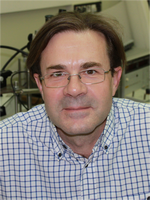
CSIC Senior Researcher
riqjim@icmm.csic.es
Got his B.S. degree and Master degree in Chemistry (Electrochemistry) in 1989 and 1990, respectively, at the U.A.M University. Got his Ph .D in Chemistry by the U.A.M. university in 1994. He had a postdoctoral stay at the “Laboratoire de electrochimie et physico-chimie of solids and interfaces” at the ENSEEG in Grenoble (France). After this period he entered the Ferroelectric Materials Department at the ICMM/CSIC in Madrid (1997). He had an advanced grant (Ramon&Cajal Program, Spanish MCyT) from 2001 to 2005. From June 2005 he is Permanent Staff of CSIC, Tenure Scientist, at the Department of Ferroelectric Materials.
Brief CV
- Is author of more than 106 articles published in different journals included in the S.C.I.. More than 14 contributions to collective volumes. Has participated in mre than 40 scientific international meetings including 8 invited talks and 26 oral presentations.
- Director of the “Departamento de Materiales Ferroeléctricos-ICMM(2006)”.
- ICMM representative at the working group “Processing” of the EC-COST528 Action (2000-2005).
- Researcher participant at the COST539 Action on “Electroceramics from Nanopowders Produced by Innovative Methods” (2005- ).
Projects
He has participated in several European research activities as the project: ”The Synthesis, Characterization and application of pillared layered clays” (BRITE /EURAM II), the COST514 and 528 actions. He was participant in integrated actions with Portugal (Departamento de Engenharia Ceràmica e do Vidrio, Univ. Aveiro) on “Ferroelectric thin films: preparation and characterization” (2001) and France (Univ. Nancy) “Ferro-piezoelectric thin films for SAW and DRAM devices: preparation and characterization of the physical and chemical properties”. Has participated in more than 11 national research projects. Nowadays is project leader of “The study of the ferro-paraelectric phase transition in modified lead titanate with high Ca content and its microelectronics applications” (MCyT y C.S.I.C) and the integrated action with Brasil (Universidade de Fortaleza Ceara Dep. Physics (LOCEM)) on “The study of high permittivity materials with perovskite structure”.
Current Projects
- “Materiales para electrodos y electrolitos en baterías de Litio y celdas de combustible” MAT2010-19837-C06-02
- “Capas y multicapas delgadas ferroelectricas para dispositivos integrados. Composiciones y metodos de deposito quimico de disoluciones de bajo impacto ambiental” MAT2010-15365.
Expertise
His formation in solid-state electrochemistry joined with his experience in ferroelectric materials characterization lead to Dr. Jiménez wide expertise in the electrical characterization of electroceramics1 in both bulk and thin film. This includes for example the low field a.c. electrical characterization2, 3 (impedance spectroscopy), especially in low frequency measurements in a wide range of temperature (77K ≤ T ≤ 1273K). In the high field characterization (ferroelectric materials) his expertise has allowed to introduce a new characterization technique: the pulsed hysteresis loop, very suitable for ferroelectric thin films. On the other hand, he has experience in preparation and physical properties of composite materials, dynamical thermomechanical measurements and in the refinement of crystal structures by Rietveld method.
Research Interests
Electrical properties of ferroelectric thin films; Fabrication of ferroelectric thin films at low temperatures by novel Chemical Solution Deposition Methods; Broad-band dielectric spectroscopy applied to solid electrolytes and ferroelectric materials; Ionic conductivity mechanism in Li conducting perovskites and NASICON related structures; Electrochemical electricity generators. Solid oxide Fuel Cells and Fuel cells based on bacteria.
